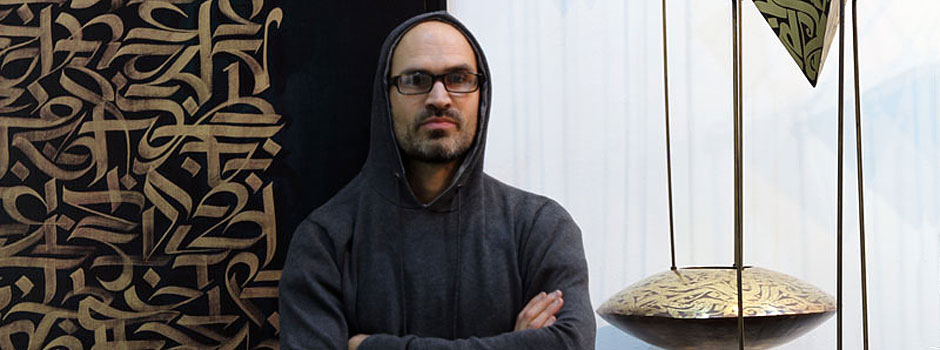
An Interview with graffiti artist Vincent Abadie Hafez aka Zepha The Energy of Calligraphic Gestures
Aug 28, 2012 Interview

 A mural with latin-arabic lettering painted by Vincent Abadie Hafez aka Zepha / Courtesy of the Artist
A mural with latin-arabic lettering painted by Vincent Abadie Hafez aka Zepha / Courtesy of the Artist
As far back as I can remember, I see myself with a pen or pencil in my hand, expressing myself on any surface available. As a child, I was distracted and in my own world. The punishments I received at primary school from my teachers for this, that is writing over and over sentences such as 'I must not look out the window during the class,' or 'I cannot draw during the class' in fact actually improved my handwriting. When I was about 7 years old, one of my favorite activities and also my first “success“ was faithfully copying banknotes; the bill of 100 francs with 'Liberty Leading the People' by Eugène Delacroix was my favorite. I also passionately loved prehistory and therefore also spent time looking for fossils and carving flint. Then at the age of 10, I became interested in Picasso, particularly his famous painting 'Les Demoiselles d'Avignon', as well as in African and ancient art, the minimalist sculptures produced by the Cycladic civilization, and, via the Louvre Museum, the rich and impressive department devoted to Islamic art.
By the late 80s, I was engaged body and soul in the Graffiti movement that had appeared a few years earlier in Paris and Europe more generally, under the pseudonym Zepha. My experience with the graffiti movement brought me its share of adventures with its nights out spraying and making collective paintings and, more significantly, alllowed me to work in depth on the subversion and stylization of the Latin alphabet.
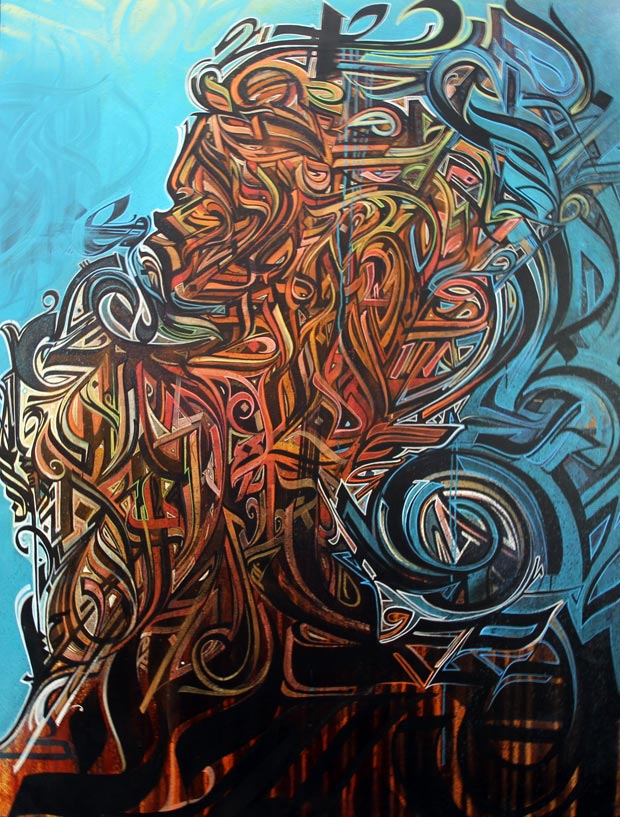 Les 7 Soeurs, Mixed media, 182x140cm, 2011 / Courtesy of the Artist
Les 7 Soeurs, Mixed media, 182x140cm, 2011 / Courtesy of the Artist
My 'art career' began in the streets with wild or primal 'graffiti', most often collective works done in the middle of the night on all types of urban surfaces. First an act of utopian revolt rejecting an overly materialistic world, graffiti is for me like the battle led by Don Quixote against windmills in the Cervantes novel. It is a graphic struggle using the known codes of advertising, especially its visual violence, to seek validation and self affirmation. An egocentric rite of passage and a search for identity through the colored medium of expression, graffiti remains today a creative passion of young people from megalopolises the world over and, in my opinion, also a catalyst, a way of letting off steam that transforms negative energy into positive energy.
Today, my art work has begun to be recognized internationally, and it now forms part of the art market but I am trying to preserve the core values essential to graffiti that conditioned my approach to art: the spirit of calligraphy allied to movement that comes from the aerosol paint medium, the desacralization of art, taking it outside of the museum and making it public, the preservation of the collective and cooperative spirit that encourages artists to paint together on the same surface and, last but not least, the maintaining of the rebellion against the established order intrinsic to this form of street art.
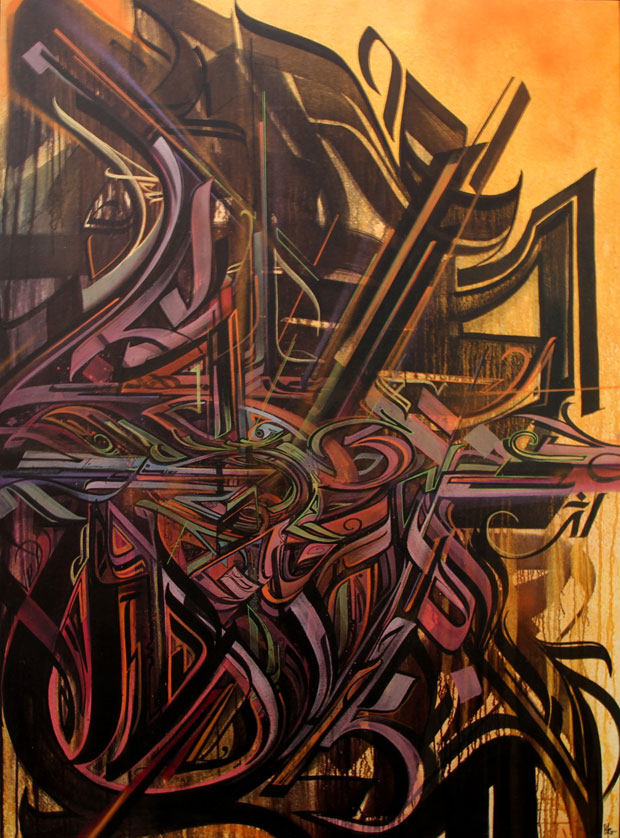 Memento Mori, Mixed media, 188x140cm, 2011 / Courtesy of the Artist
Memento Mori, Mixed media, 188x140cm, 2011 / Courtesy of the Artist
While I was working on 'street' surfaces such as walls, trains, trucks, cars and other urban backgrounds, I also produced studio work on canvas, paper and copper. Training with a master blacksmith and artist, Guy Labrouche, gave me a lot, and deepened my knowledge of the ancient material of copper. This encounter instigated my work with the hammering of metal and the study of ornamental design on metal. The discussions with this humanist artist confirmed for me the importance of the actual process of creation of a work of art, which connects with the basic idea of the 'action art' that graffiti is for me. Copper, as the first metal used by man along with gold seduced me with with its alchemical symbolism associated with Venus which also relates to the role of the matrix in traditional printing.
Observing the oxidation and intrinsic properties of this metal essential to all forms of life, led me to be interested in etching which consists of creating a design on the copper plate with acid, then covering the plate in ink and passing it through the press to create multiple prints on paper. My graphic vocabulary is engraved on these metal 'matrixes', veritable living works, which react or not depending on the patina applied and the oxygen of the ambient air, evoking the idea of the metamorphosis of life (nothing is lost, nothing is created, everything transforms itself) and of transcendence illustrated by my calligraphic markings and signs.
 Clepsydres sonores - Abstract gold by Vincent Abadie Hafez aka Zepha / Courtesy of the Artist
Clepsydres sonores - Abstract gold by Vincent Abadie Hafez aka Zepha / Courtesy of the Artist
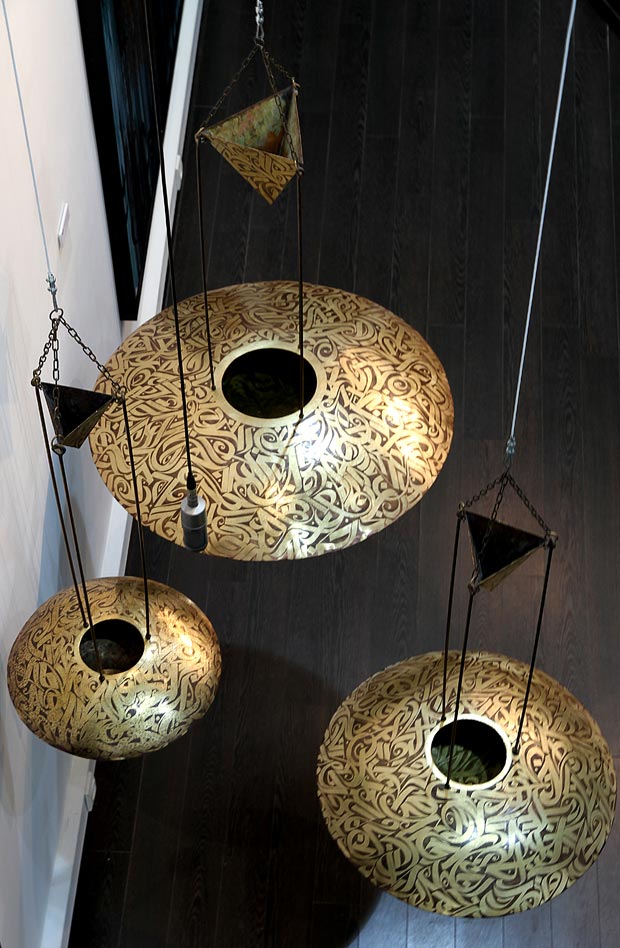 Clepsydres sonores by Vincent Abadie Hafez aka Zepha / Courtesy of the Artist
Clepsydres sonores by Vincent Abadie Hafez aka Zepha / Courtesy of the Artist
Another part of my work is represented by the technique that I call 'Palimpsest' which consists of writing calligraphy in reserve on covered texts in liquid latex only to make them re-appear by 'rubbing' or 'scraping'. This pictorial technique gives meaning to the process of art making through the act of 'discovering' the hidden words or phrases. It also allows me, in in situ installations, to enable public participation in the making of a collective art work thereby allowing the public to influence the final esthetic resullt. Works that can't be defined in advance, carriers of hidden messages discovered only if curious passers-by come and rub the work with their hands: the memory of acts, the trace of a thought once only oral, and, why not, the return of the lost truth...
 My destiny, Palimpseste on canvas / Courtesy of the Artist
My destiny, Palimpseste on canvas / Courtesy of the Artist
The gesture intrinsic to the aerosol technique and the energy of calligraphic gestures led me to live creativity as a process, not only as a goal. This notion later influenced my post-graffiti graphic research and inclination towards abstraction. It became an alphabetical choreography, tending towards what I call the 'trance of signs'. When I create I am close to a state of transcendence, a deep dive into the All, the One, which goes beyond the duality of the signifier - signified.
To access this depth of soul, this collective memory is the artist's mission, now more than ever, to make visible and communicate the receptive being that is Man. We are just passing through and our message as artists is to re-enchant certainly, but also and especially, to push human consciousness to stand against things like prosperity without sharing, a selfish withdrawal from society, and collective amnesia all of which should belong to the past. In my works and installations, there is a pretension to call into question the irresponsible and corrupt globalized system. The letter or calligraphic sign, this 'typography', is so special and arising out of another era, it constitutes the necessary foundation for me to address these critical issues: a free and full corpus that takes the human thought and spirituality of the past into account and the primordial ties that unite people, a shared memory between East and West, which guarantees a common awareness of the need to build a more altruistic world.
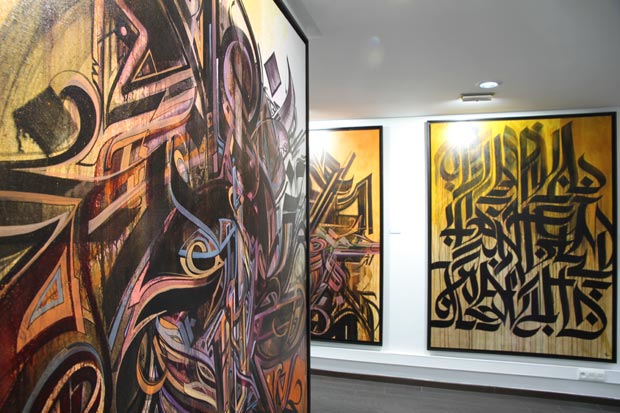 'Inside job' at David Bloch Galery / Courtesy of the Artist
'Inside job' at David Bloch Galery / Courtesy of the Artist
My calligraphic work, although possessing a Latin base, is strongly inspired by traditional and contemporary Arabic calligraphy. My alphabet is Latin in its meaning and Arabic in its style.
Sometimes, my characters lose their meaning in favor of the power of movement, the gesture of the calligraphy pen stroke on paper, the brush stroke on canvas, the spray paint on the wall, all a balancing game between planned composition and instinctive gesture.
My encounter in 1998 with calligrapher and artist Abdellatif Moustad profoundly influenced my work leading me to an approach centered on the calligraphic gesture and the composition of the Arabic letters as well as on the relationship between matter and support. This also led me to put figuration aside and privilege the letter.
![]() Street art by Vincent Abadie Hafez aka Zepha / Courtesy of the artist
Street art by Vincent Abadie Hafez aka Zepha / Courtesy of the artist
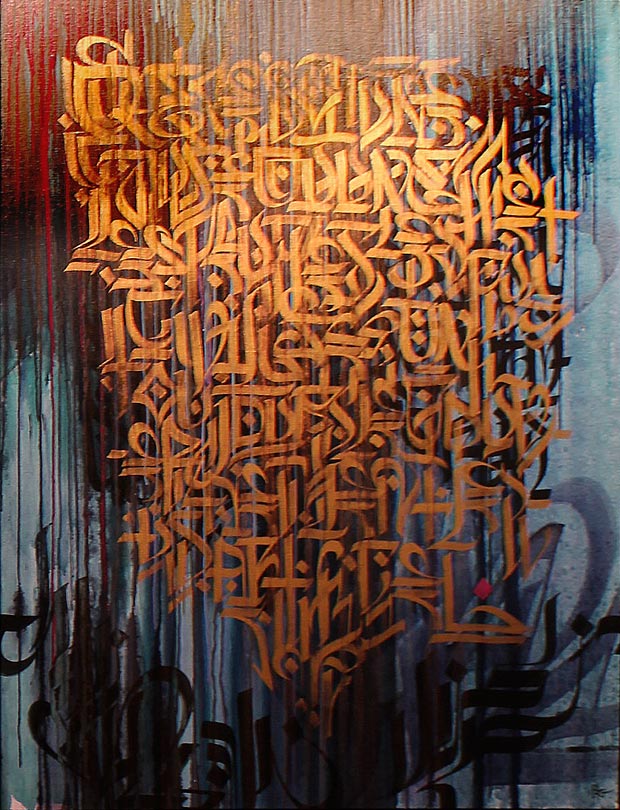 Que ce soit une cause ou un effet, Mixed media, 163x131cm, 2011 / Courtesy of the Artist
Que ce soit une cause ou un effet, Mixed media, 163x131cm, 2011 / Courtesy of the Artist
Contemporary Islamic art today is garnering increasing attention and it too is confronting the paradoxes of modern society. Hassan Massoudy and Rashid KoraÑ—chi for me, are the pioneers who opened the way towards a certain idea of what contemporary calligraphic rooted in Islamic culture could be. I also deeply admire the calligraphy and visual art of the late Sudanese artist Ahmed Abdel Aal.
Through other media such as photography and video, artists such as Mohamed Bourouissa and Yto Barrada raise, in different degrees, interesting questions concerning contemporary social problems. My post-graffiti work is close to that of artists of the French art scene, such as L'Atlas, El Seed, Sowat, Sunset, El Tono and Rizote. All of them, and many others whom I haven't mentioned, are, like me, exploring the notion and dynamics of writing —the letter and the sign— and its relationship to public space.
Comments
Add a comment